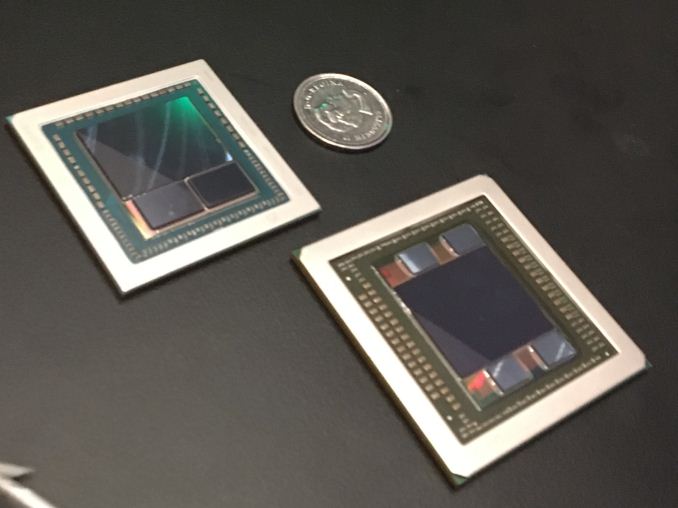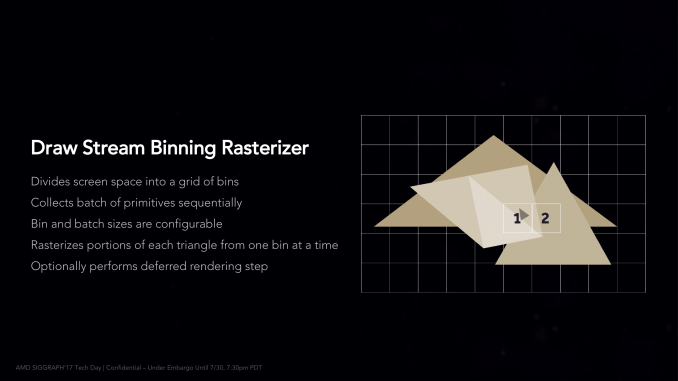Radeon RX Vega Unveiled: AMD Announces $499 RX Vega 64 & $399 RX Vega 56, Launching August 14th
by Ryan Smith on July 30, 2017 10:30 PM ESTFeatures & the Future Launch
Last but not least, along with today’s card announcements, AMD has also lifted the embargos on the architectural elements of the Vega 10 GPU. While there are no new architecture features to discuss – it turns out AMD was rather thorough with their preview at the start of this year – there’s still quite a bit in the way of details to dig into here. In fact it's more than I can hope to cover in a single day, let alone the few hours I’m getting to write this article ahead of AMD’s embargo. So I want to hit the highlights.
First and foremost, AMD has clarified that they do not consider Vega 10 to be a high performance computing (HPC) chip, unlike Hawaii. In particular, Vega 10’s native FP64 rate is just 1/16, like AMD’s other consumer chips. And the chip, while supporting HBM2’s native ECC mode, doesn’t have ECC on its internal pathways. This doesn’t mean that the chip can’t be placed in a server – its FP16 and INT16/INT8 performance is the cornerstone of its existence as part of the Radeon Instinct family. But that’s still a different market than traditional HPC. When we might see another HPC chip from AMD is anyone’s guess at this moment.
Second of all, we have a formal die size and transistor count for Vega 10. The GPU is officially 486mm2, containing 12.5B transistors therein. That amounts to 3.9B more transistors than Fiji – an especially apt comparison since Fiji is also a 64 CU/64 ROP card – all the while being 112mm2 smaller than Fiji (despite the higher transistor count) thanks to the higher density of GloFo’s 14nm LPP process, which AMD is using to fab the chip.
Talking to AMD’s engineers, what especially surprised me is where the bulk of those transistors went; the single largest consumer of the additional 3.9B transistors was spent on designing the chip to clock much higher than Fiji. Vega 10 can reach 1.7GHz, whereas Fiji couldn’t do much more than 1.05GHz. Additional transistors are needed to add pipeline stages at various points or build in latency hiding mechanisms, as electrons can only move so far on a single clock cycle; this is something we’ve seen in NVIDIA’s Pascal, not to mention countless CPU designs. Still, what it means is that those 3.9B transistors are serving a very important performance purpose: allowing AMD to clock the card high enough to see significant performance gains over Fiji.
Speaking of Fiji, there’s been some question over whether the already shipping Vega FE cards had AMD’s Draw Steam Binning Rasterizer enabled, which is one of the Vega architecture’s new features. The short answer is that no, the DSBR is not enabled in Vega FE’s current drivers. Whereas we have been told to expect it with the RX Vega launch. AMD is being careful not to make too many promises here – the performance and power impact of the DSBR vary wildly with the software used – but it means that the RX Vega will have a bit more going on than the Vega FE at launch.
Fifth, AMD is tweaking their boost clock mechanism and how it's advertised. Up until now, the boost clock was the maximum clock a Radeon card would hit. e.g. a stock Fury X topped out at 1.05GHz, and a stock RX 580 at 1340MHz. Starting with Vega RX, however, the company's definition of the boost clock is changing to the highest clockspeed a card is guaranteed to hit, but not the absolute highest clockspeed it can hit under load. There are still some nuances I want to test once I have the hardware in-hand, but at first glance this sounds closer to NVIDIA's definition, where each and every card is allowed to reach its natural limit (for the stock voltage).
Finally, while AMD didn’t clarify exactly when this change was made, the company has tweaked their Freesync Low Framerate Compensation technology to work with monitors that have a 2x range between min and max refresh rates, as opposed to 2.5x at launch. I’m told that 2.5x (or better) is still the ideal range, but it now works at 2x. This is an important development because the Samsung CF791 monitor that AMD is discounting as part of the Radeon Pack bundles has a 48Hz to 100Hz range; so it wouldn’t have been LFC capable under the old LFC rules.
Overall AMD has given us a lot to chew on – and more that can be covered in a single afternoon – but we still haven’t seen the whole picture. Today’s announcement of the card specifications and prices sets a very important baseline for what we should expect on August 14th, but no hard performance numbers to judge the final product. As I said at the start of this article, AMD’s marketing has done a very good job keeping Vega in the public’s mind. And today’s announcement is the next phase of that plan. But the end is approaching, and RX Vega’s full launch is drawing near, so it will be very interesting to see how everything we’ve learned over the last several months translates into gaming performance, power efficiency, and where AMD’s new place shall be in the realm of high-end video cards.













162 Comments
View All Comments
guidryp - Sunday, July 30, 2017 - link
Regardless of the competitive landscape, we shouldn't applaud this kind of dragged out, train wreck of a marketing job, ending in an embarrassing product release.For the future, I suggest one piece of advice: "Put up, or shut up".
Nagorak - Monday, July 31, 2017 - link
It's not the marketing department's fault: the architecture is just junk. They did the best they could with the severe delays, and have tried to put lipstick on a pig. I don't know how you can hold it against the marketing department. It's the engineers who clearly need to get their act together.Walletripper - Monday, July 31, 2017 - link
I wouldn't exactly call it junk. Just look at where AMD has come from. Now you can get an 8 core 16 thread 64PCIE lane processor for probably around $500 at Microcenter and a $300 plus 4k graphics card that will go excellent with a low cost freesync monitor. If AMD had failed you would be paying $4 grand for a setup like that. AMD now offers that for around $1500 very soon. Intel will counter and AMD will counter then it's time to buy. A year ago I never dreamed that I would be able to afford such hardware and I will never forget the Intel tick tock rip off marketing. I will only buy AMD from now on. If you are smart you will also.Hurr Durr - Monday, July 31, 2017 - link
>I will only buy AMD from now on>talks about being smart
Sometimes the ironing on AT is beyond delicious.
vladx - Monday, July 31, 2017 - link
Do you really expect intelligence from AMD fanbois? Good luck with that.tuxRoller - Monday, July 31, 2017 - link
If you nixed the AMD part, you'd might be right though I'd choose to say objectivity, or good judgement since I not aware of good data linking intelligence with fanboiosity.Tewt - Monday, July 31, 2017 - link
LOL. Oh, the IRONY of this statement.Ej24 - Monday, July 31, 2017 - link
Amd cpu's and gpu's come from what are essentially different companies. Amd spun Radeon graphics off in to Radeon Technology Group. Most likely to insulate the parent corporation in the event that the Radeon group fails and needs to be sold to the highest bidder.Nagorak - Monday, July 31, 2017 - link
The Vega that's being presented is not a 4K card. Performance just isn't there. Even 1080 Ti struggles at 4K. But the icing on the cake is that the 1080 Ti puts out much more performance than RX Vega, while still seemingly using less power.I've been a supporter of AMD for a long time, but this is just pathetic.
Arbie - Monday, July 31, 2017 - link
"I will only buy AMD from now on. If you are smart you will also."Bravo. I had been buying Intel and NVidia because AMD was technically inferior (worst in CPUs). But thinking about Ryzen, what it takes to create something like that, and AMD's chronic near-bankruptcy, I realized that we are damned lucky they have survived and are still punching. My money now goes to (1) Reward the people who are *really* trying and (2) Keep them in the game.
Do you assume AMD can pull off such a recovery twice? If too many of us say "yeah, but I can get a few more FPS from an Intel / NVidia rig", we could very well have only those two in the future.
The bottom line: Don't niggle about minor tech differences; there's much more at stake. Buy AMD where you reasonably can - and they do offer a LOT now. I bought Ryzen 1800X and will buy Vega.